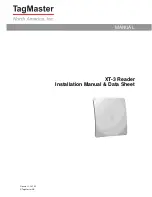
be installed 10ft. (3m) back from discharge grille. A flex or lined duct is recommended for
the last 5ft. (1.5m). Robertshaw dampers are 2 position dampers. Two wire dampers are
powered closed and spring return open. Three wire dampers are powered closed and
powered open. For applications requiring minimum air ventilation, an adjustment screw is
available to set the damper to a specified minimum open position. Robertshaw dampers
are shipped from the factory with the minimum position adjustment screw in the fully
closed position; allow for 3% to 5% leakage with damper closed. The control panel has 3
terminals for each damper which are (refer to Figure 4.2):
PC:
power damper closed
X:
common
PO:
power damper opened
Power to the dampers is provided by the panel.
NOTE:
High ambient temperatures (e.g., those found in an attic), will have an impact on the
current capabilities of the panel and the number of zone dampers that can be connected to
the panel. The 2701-001 and 2701-006 are powered by a single 75 VA transformer. This
transformer is used to power the panel, thermostats and motorized dampers. The ambient
temperature will have an impact on the Polyfuse current limiting protection. The maximum
number of dampers that can be connected to the total system using Robertshaw dampers are:
At 25ºC (77ºF)
At 40ºC (104ºF)
6 E Series dampers
5 E Series dampers
5 E2 Series dampers
4 E2 Series dampers
6 E3 Series dampers
5 E3 Series dampers
If additional dampers are required you must use a relay to energize these additional
dampers from an independent source.
4.6
BYPASS DAMPER SYSTEM
In order to maintain proper air flow and static pressure throughout the HVAC system, a
bypass system should be used. In some 2 zone applications a bypass damper may not be
required. This is based on duct sizing where either zone is able to handle approximately
75% of the total system CFM (cubic feet/minute). This will result in only slightly higher air
velocity at the discharge grille if only one zone is calling and yet allow for proper CFM
across the cooling coil. In many smaller commercial and most residential zone systems, a
barometric bypass damper is all that is required to maintain proper system static pressure.
In larger systems, a motorized bypass damper with an independent static pressure control
will be required.
4.6.1 INSTALLING THE BYPASS DAMPER
The bypass damper must be installed in the main supply plenum in a straight section of
equal duct size. The bypass air may be discharged into the return air plenum or above the
ceiling, if this area is used as a common return.
SlimZone Classic
6





































